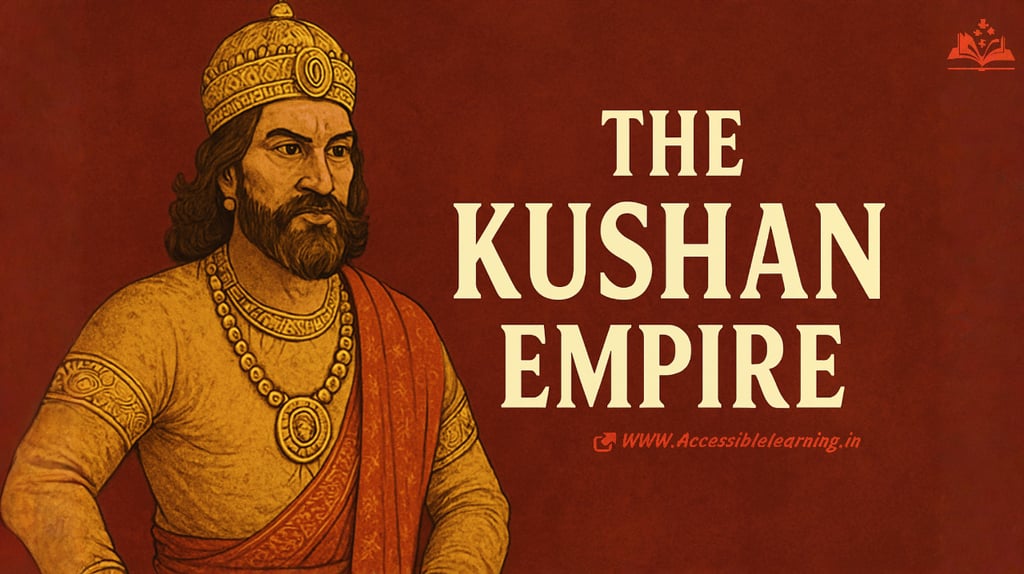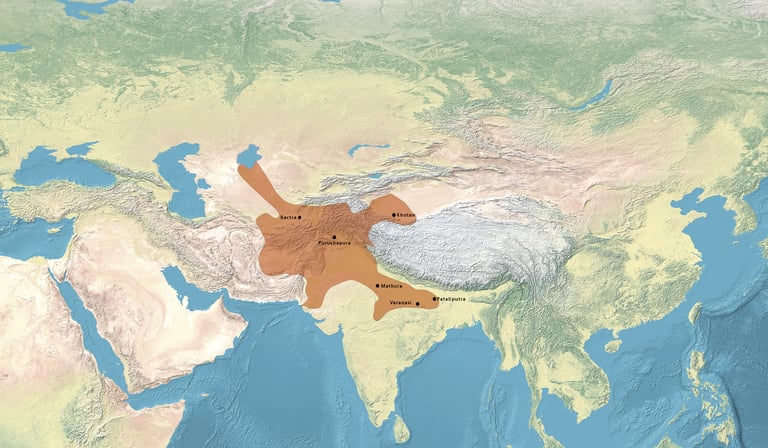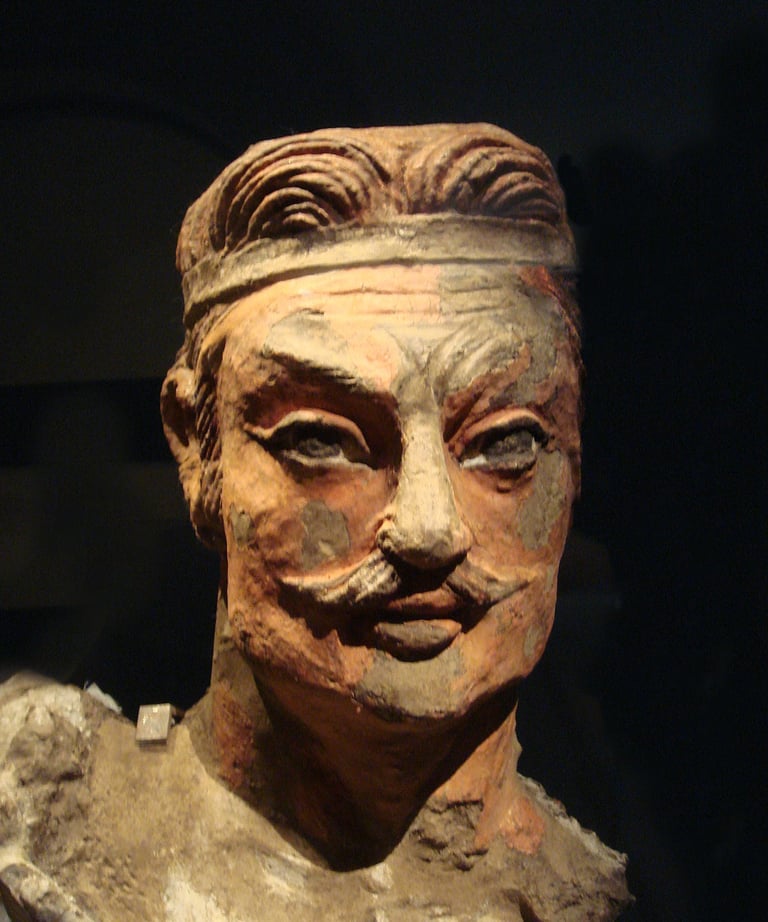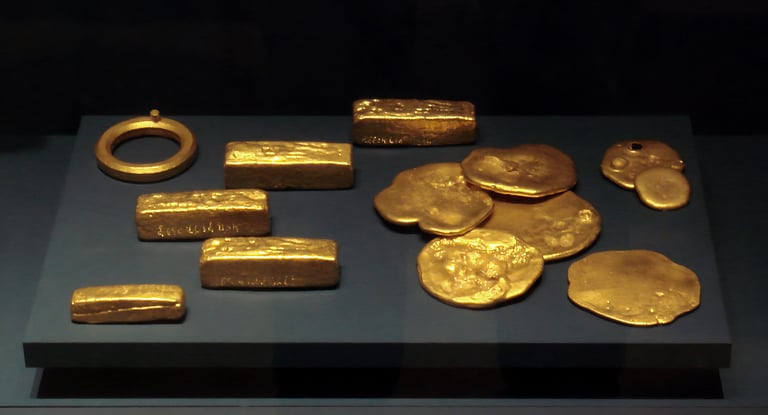
The Kushan Empire: Ancient Central Asia's Greatest Trading Power and Cultural Bridge
Discover the Kushan Empire (1st-3rd century CE), ancient Central Asia's greatest trading power that controlled the Silk Road, spread Buddhism, and created remarkable cultural synthesis between East and West.
INDIAN HISTORYEMPIRES/HISTORYHISTORY
Keshav Jha
8/19/202511 min read


The Kushan Empire stands as one of history's most influential yet underappreciated civilizations, controlling vast territories across Central Asia, Afghanistan, northern India, and parts of China from approximately the 1st century BCE to the 3rd century CE. This remarkable empire served as the crucial link between East and West, facilitating unprecedented cultural exchange and establishing trade networks that would define the ancient world for centuries.
What Was the Kushan Empire? A Comprehensive Overview
The Kushan Empire emerged from the Yuezhi confederation, a nomadic people who migrated from the Tarim Basin following pressure from the Xiongnu confederacy. After conquering Bactria in the 2nd century BCE, the Yuezhi established five principalities, with the Kushans eventually dominating the region and expanding their influence across the ancient world.
The empire reached its zenith under Emperor Kanishka I (reigned ca. 127-150 CE), whose domain stretched from the Aral Sea to the Ganges River, encompassing modern-day Afghanistan, Pakistan, northern India, Tajikistan, Uzbekistan, and parts of China and Iran. This vast territory positioned the Kushans as the ultimate middlemen in ancient global commerce.
Origins & Formation of the Kushan Dynasty
The Yuezhi Migration and Bactrian Conquest
The foundation of the Kushan Empire traces back to the Great Yuezhi migration around 165 BCE. These Indo-European-speaking nomads, originally inhabiting the Gansu corridor in northwestern China, were forced westward by Xiongnu expansion. The Yuezhi confederation conquered the Greek kingdom of Bactria, establishing themselves as the new rulers of this strategically vital region.
The transformation from nomadic confederation to sedentary empire occurred gradually over several generations. The Kushans, one of five Yuezhi tribes, emerged as the dominant force under their first great ruler, Kujula Kadphises (r. 30-80 CE), who unified the fragmented territories and began the systematic expansion that would define the empire.
Archaeological Evidence of Early Kushan Settlement
Recent archaeological discoveries continue to illuminate the early Kushan period. In 2025, archaeologists in Tajikistan uncovered a clay vessel with a complete Bactrian-language inscription at the Khalkhajar site, providing new insights into Kushan administrative practices and cultural development. Such finds demonstrate the empire's sophisticated bureaucracy and multilingual administration.
The Khalchayan palace complex reveals the unique Kushan artistic synthesis, combining Hellenistic, Iranian, and Central Asian elements. Sculptures from this site show characteristic artificially deformed skulls, a practice common among Central Asian nomads that the Kushan elite maintained even after sedentarization.

Geographic Extent and Territorial Control
The Empire at Its Peak
Under Kanishka I, the Kushan Empire controlled approximately 2 million square kilometers, making it one of the four great powers of the ancient world alongside Han China, Parthian Iran, and the Roman Empire. The empire's territories included the entire Hindu Kush mountain range, the fertile valleys of Bactria and Sogdiana, the Gandhara region, and significant portions of northern India extending to the Ganges plain.
The empire's geographic position was strategically unparalleled. It controlled the crucial mountain passes connecting Central Asia with the Indian subcontinent, including the Khyber Pass and other routes through the Hindu Kush. This territorial control allowed the Kushans to dominate transcontinental trade and extract significant revenues from customs duties and protection fees.
Provincial Administration and Regional Governance
The Kushan Empire employed a sophisticated administrative system that balanced centralized control with local autonomy. The empire was divided into satrapies governed by regional administrators who maintained local customs while implementing imperial policies. This flexible approach to governance enabled the Kushans to maintain control over diverse populations speaking different languages and following various religious traditions.
Archaeological evidence from sites like Begram (ancient Kapisa) demonstrates the cosmopolitan nature of Kushan administration. Excavations have revealed Roman glass, Chinese lacquerware, and Indian ivory carvings, illustrating the international character of Kushan cities and their role as centers of cultural exchange.
The Silk Road: Kushan Control and Economic Dominance
Masters of Ancient Global Trade
The Kushan Empire's greatest achievement lay in its control and development of the Silk Road trade network. The empire's territory encompassed critical segments of both the northern and southern routes connecting China with the Mediterranean world, positioning the Kushans as essential intermediaries in ancient global commerce.
Kushan merchants and administrators facilitated the exchange of Chinese silk, Indian spices and textiles, Central Asian horses, and Mediterranean luxury goods. The empire's standardized coinage, featuring Greek, Bactrian, and Sanskrit inscriptions, served as a common medium of exchange across vast distances, demonstrating the Kushans' role in creating the world's first truly international monetary system.
Commercial Cities and Trading Centers
The Kushan Empire developed numerous commercial centers that served as hubs for international trade. Peshawar (ancient Purushapura) functioned as a major administrative and commercial center, while Mathura in northern India became a crucial node connecting Central Asian trade routes with maritime networks in the Arabian Sea.
Begram, serving as the empire's summer capital, exemplifies the international character of Kushan commerce. Archaeological excavations have revealed warehouses containing goods from across the known world, including Roman bronzes, Chinese ceramics, and Indian precious stones, demonstrating the empire's role in facilitating unprecedented cultural and economic exchange.
Religious Tolerance and Cultural Synthesis
Buddhism & Imperial Patronage
The Kushan Empire played a pivotal role in the spread of Buddhism, particularly the Mahayana tradition. Emperor Kanishka I convened the Fourth Buddhist Council, which standardized Buddhist doctrine and practices across Central Asia and beyond. Under Kushan patronage, Buddhism experienced significant theological development and geographical expansion.
The empire's support for Buddhism extended beyond theological matters to include substantial material patronage. Kushan rulers commissioned massive stupas, monasteries, and artistic works that spread Buddhist iconography and ideas across their vast territories. The famous Gandhara school of art, which blended Hellenistic and Indian traditions, flourished under Kushan patronage and created enduring masterpieces of Buddhist sculpture.
Religious Pluralism & Syncretism
Despite their patronage of Buddhism, Kushan rulers maintained remarkable religious tolerance. Archaeological evidence reveals temples dedicated to Hindu deities, Zoroastrian fire altars, and Greek religious sites operating simultaneously within the empire. This religious pluralism reflected the empire's diverse population and demonstrated the Kushan commitment to inclusive governance.
The religious diversity of the Kushan Empire facilitated unprecedented theological exchange. Buddhist concepts influenced local traditions while absorbing elements from Hellenistic, Iranian, and Indian religious systems. This syncretic approach created new religious movements and philosophical schools that would influence spiritual development across Asia for centuries.
Art, Architecture, and Cultural Achievements
The Gandhara School of Art
The Kushan period witnessed the flowering of the Gandhara school of art, representing one of history's most successful cultural syntheses. This artistic tradition combined Hellenistic sculptural techniques with Buddhist iconography and Central Asian motifs, creating a distinctive style that influenced artistic development across Asia.
Gandhara sculptures demonstrate sophisticated artistic techniques, including realistic portraiture, classical drapery treatment, and complex narrative compositions. These works not only served religious purposes but also functioned as diplomatic gifts and trade goods, spreading Kushan cultural influence far beyond the empire's political boundaries.
Architectural Innovations and Monumental Construction
Kushan architecture reflected the empire's multicultural character and technological sophistication. The rulers constructed massive stupas, fortified cities, and palatial complexes that incorporated architectural elements from Greek, Iranian, and Indian traditions.
The Surkh Kotal temple complex exemplifies Kushan architectural achievement, featuring a monumental stepped structure combining Mesopotamian ziggurat concepts with Indo-Iranian religious architecture. Recent archaeological investigations have revealed sophisticated engineering solutions, including advanced water management systems and seismic-resistant construction techniques.


Economic System and Trade Networks
Monetary Innovation and Standardization
The Kushan Empire developed one of the ancient world's most sophisticated monetary systems, featuring standardized gold, silver, and copper coins that facilitated trade across vast distances. Kushan coinage displayed remarkable artistic quality and served as vehicles for imperial propaganda, featuring portraits of rulers alongside religious and cultural symbols.
The empire's monetary system demonstrated remarkable adaptability, incorporating Greek weight standards, Roman artistic influences, and local religious iconography. This flexible approach to currency design enabled Kushan coins to gain acceptance across diverse markets and cultural regions.
Agricultural Productivity and Urban Development
The Kushan Empire's prosperity rested on a foundation of agricultural innovation and urban development. The empire's territories included some of the world's most fertile regions, including the Bactrian plains and the Indus River valley, which supported dense populations and generated significant agricultural surpluses.
Kushan cities featured advanced infrastructure, including sophisticated water management systems, planned street layouts, and specialized commercial districts. Archaeological evidence reveals extensive craft production, including metalworking, textile manufacturing, and luxury goods production that supplied both local markets and international trade networks.
Major Rulers and Political Development
Kujula Kadphises: The Empire Builder
Kujula Kadphises (r. 30-80 CE) established the foundation of Kushan imperial power through military conquest and administrative innovation. He unified the fragmented Yuezhi principalities and began the systematic expansion that would characterize the empire's golden age.
Under Kujula's leadership, the Kushans adopted sedentary administrative practices while maintaining their military prowess. He established the imperial capital at Begram and initiated the standardization of weights, measures, and currency that would facilitate the empire's commercial success.
Kanishka I: The Great Conqueror
Kanishka I (r. ca. 127-150 CE) represents the pinnacle of Kushan power and influence. His reign marked the empire's greatest territorial expansion and its emergence as a major force in ancient global politics. Kanishka's military campaigns extended Kushan control deep into the Indian subcontinent and secured dominance over Central Asian trade routes.
Recent scholarship, based on the Rabatak inscription discovered in Afghanistan, has revised the traditional chronology of Kanishka's reign, placing it in the early 2nd century CE rather than the late 1st century. This chronological adjustment has important implications for understanding the empire's relationship with contemporary powers and its role in ancient international relations.
Military Organization and Warfare
Cavalry Supremacy and Tactical Innovation
The Kushan military retained the cavalry traditions of their nomadic ancestors while adapting to the requirements of governing sedentary populations. Heavy cavalry formed the core of Kushan armies, featuring armored horsemen equipped with lances, bows, and swords.
The empire's military success resulted from combining traditional nomadic mobility with sophisticated siege warfare techniques learned from Hellenistic and Iranian traditions. Kushan forces demonstrated remarkable adaptability, fighting effectively in the mountains of Afghanistan, the plains of Central Asia, and the river valleys of northern India.
Fortification Systems and Border Defense
The Kushans constructed extensive fortification systems to protect their vast territories from external threats and internal rebellions. Archaeological evidence reveals sophisticated fortress designs incorporating multiple defensive lines, advanced siege engines, and strategic positioning to control key mountain passes and river crossings.
The empire's border defenses reflected a comprehensive understanding of military geography and logistics. Fortified cities served dual purposes as commercial centers and military bases, enabling the rapid deployment of forces to threatened regions while maintaining economic activity.
Decline and Legacy of the Kushan Empire
Internal Challenges and External Pressures
The decline of the Kushan Empire resulted from a combination of internal fragmentation and external military pressure. By the 3rd century CE, the empire faced increasing challenges from the resurgent Sasanian Empire in the west and emerging Indian kingdoms in the south.
Internal succession disputes weakened central authority and enabled provincial governors to assert greater independence. The empire's vast size, which had been a source of strength during its expansion, became a liability as communication difficulties and administrative costs strained imperial resources.
Transformation and Successor States
Rather than experiencing sudden collapse, the Kushan Empire underwent gradual transformation into smaller regional kingdoms. The Kidara Kushans maintained control over portions of Afghanistan and northern Pakistan, while the Alchon Huns eventually established dominance over former Kushan territories in Central Asia.
The empire's legacy persisted through its cultural and religious contributions rather than its political structures. The Buddhist monasteries, trade networks, and artistic traditions established during the Kushan period continued to influence Central and South Asian development for centuries after the empire's political fragmentation.


Archaeological Discoveries and Recent Research
Contemporary Archaeological Investigations
Recent archaeological research continues to reveal new aspects of Kushan civilization and culture. The 2025 discovery of a Bactrian inscription at Khalkhajar in Tajikistan provides fresh evidence of the empire's administrative practices and linguistic diversity.
Investigations at the Almosi Gorge site have revealed what researchers believe may have been hunting enclosures used by Kushan nobility, demonstrating the persistence of nomadic cultural practices among the empire's elite classes. These findings illustrate the complex process of cultural adaptation that characterized Kushan society.
Technological Applications in Kushan Studies
Modern archaeological techniques, including satellite imagery, ground-penetrating radar, and advanced dating methods, have revolutionized understanding of Kushan settlement patterns and economic systems. These technological applications have revealed previously unknown sites and enabled more precise dating of cultural layers and artifacts.
Digital reconstruction techniques have allowed researchers to visualize Kushan monuments and cities in their original form, providing insights into architectural planning and urban development that would be impossible through traditional excavation methods alone.
The Kushan Empire's Lasting Impact on World History
Cultural Bridge Between East and West
The Kushan Empire's most enduring legacy lies in its role as a cultural bridge connecting the civilizations of East and West. The empire facilitated unprecedented exchange of ideas, technologies, and artistic traditions that enriched human civilization and established patterns of cross-cultural interaction that persist today.
The religious synthesis achieved during the Kushan period, particularly the development of Mahayana Buddhism and its spread to China and Southeast Asia, represents one of history's most significant cultural transformations. The artistic traditions established during this period influenced development across Asia and created aesthetic standards that continued to inspire artists for centuries.
Economic Innovations and Trade Development
The Kushan contribution to ancient economic development extends beyond their role in Silk Road trade to include innovations in monetary policy, commercial law, and international business practices. The empire's standardized coinage and commercial regulations provided models for subsequent trading empires and contributed to the development of international economic systems.
The urban planning and infrastructure development achieved during the Kushan period established standards for city design and public administration that influenced Central Asian development for centuries. The empire's approach to managing diverse populations and integrating different cultural traditions provided valuable precedents for later multicultural empires.


FAQ's
Q: When did the Kushan Empire exist, and how long did it last?
The Kushan Empire existed from approximately the 1st century BCE to the 3rd century CE, lasting for roughly four centuries. The empire reached its peak during the reign of Kanishka I in the early 2nd century CE, when it controlled vast territories across Central Asia, Afghanistan, northern India, and parts of China.
Q: What territories did the Kushan Empire control at its height?
At its greatest extent under Kanishka I, the Kushan Empire controlled approximately 2 million square kilometers, including modern-day Afghanistan, Pakistan, northern India, Tajikistan, Uzbekistan, and parts of Iran and China. The empire's territory stretched from the Aral Sea in the north to the Ganges River in the south and from the Iranian plateau in the west to the Tarim Basin in the east.
Q: How did the Kushan Empire contribute to the spread of Buddhism?
The Kushan Empire played a crucial role in Buddhism's expansion, particularly the Mahayana tradition. Emperor Kanishka I patronized Buddhist institutions, convened the Fourth Buddhist Council, and supported the construction of monasteries and stupas. The empire's control of Silk Road trade routes facilitated the movement of Buddhist monks and ideas from India to China and Central Asia.
Q: What made Kushan art and culture unique?
Kushan art and culture represented a remarkable synthesis of Hellenistic, Iranian, Indian, and Central Asian traditions. The famous Gandhara school of art combined Greek sculptural techniques with Buddhist iconography, creating distinctive artistic works that influenced development across Asia. This multicultural synthesis reflected the empire's diverse population and international connections.
Q: Why did the Kushan Empire decline and eventually disappear?
The Kushan Empire declined due to a combination of internal fragmentation, succession disputes, and external military pressure from the Sasanian Empire and emerging Indian kingdoms. The empire's vast size became difficult to manage, and by the 3rd century CE, central authority had weakened sufficiently to enable the emergence of independent regional kingdoms.
Q: What archaeological evidence exists for the Kushan Empire today?
Extensive archaeological evidence for the Kushan Empire includes monumental architecture at sites like Surkh Kotal and Khalchayan, sophisticated urban centers like Begram and Taxila, and thousands of coins and inscriptions. Recent discoveries, including the 2025 Bactrian inscription found in Tajikistan, continue to provide new insights into Kushan civilization and administrative practices.
Q: How did the Kushan Empire influence modern Central Asia?
The Kushan Empire's influence on modern Central Asia includes the establishment of urban centers, trade routes, and cultural traditions that persist today. The empire's approach to managing cultural diversity and facilitating international trade provided models for subsequent Central Asian states and contributed to the region's identity as a crossroads of civilizations.
The Kushan Empire represents one of history's most successful examples of cultural synthesis and international commerce. Through their control of the Silk Road and their patronage of religious and artistic development, the Kushans created a legacy that extended far beyond their political boundaries and chronological existence.
The empire's approach to governance, trade, and cultural exchange provides valuable insights for understanding how ancient civilizations managed diversity and facilitated international cooperation. The Kushan example demonstrates that successful empires must balance military power with cultural sensitivity, economic innovation with political stability, and local traditions with international connections.
Modern research continues to reveal new aspects of Kushan civilization, confirming their central role in ancient world history and their lasting contributions to human development. As archaeological investigations progress and new discoveries emerge, our understanding of this remarkable empire will undoubtedly continue to evolve, ensuring that the Kushan legacy remains relevant for contemporary scholars and the general public alike.
Subscribe To Our Newsletter
All © Copyright reserved by Accessible-Learning Hub
| Terms & Conditions
Knowledge is power. Learn with Us. 📚


